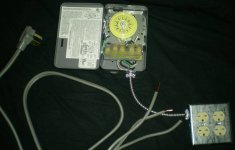PharmaCan - Hey thanks a lot. I suppose I should match the gauge of the wire in the "power strip" to the gauge of the wiring to the receptacle (at least) or do you recommend something.
Dr. Conjuror
I always used 12ga. wire for the cord and the wires to the receptacles.
Any sparkys around?I did see a diagram for wiring 2 240 outlets using the pigtail method but how to do 4?Just add to that pigtail?Please show me!!!!
Well, assuming that you have the proper size wire and the proper size circuit, then, yeah, you can just add more pigtails. You're probably coming in with 10ga. wire so, take four pieces of 12ga. wire and wire nut them on to each hot leg then run two hots, one from each leg, to each receptacle. Do the same with your ground. ...I guess that's what you're asking.
PC





